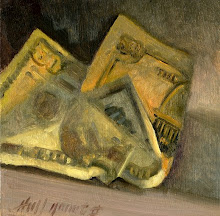Final Project
Color Theory | Art/Com 107
Professor Hall Groat | Fall 2008
Final Project
Color Schemes and Harmonies
You are to create a series of paintings that explore five different traditional color schemes and harmonies, including the analogous, complimentary, cool/warm, triadic and tetrad.
The image must address the “green movement” on some level (perhaps symbolically) and may involve a subject of your choice, such as historic architecture preservation, popular culture or endangered species. Both symbolic and expressive colors may be used to communicate your viewpoint.
Project Objective:
To objective is to understand the inner workings, and be able to implement five traditional color schemes and harmonies.
Criteria:
1. The five color schemes and harmonies must be at least 14x11 inches in size, and you are encouraged to work as large as possible.
2. The five painted images may be simplified into hardedge, patterned, geometric designs, or created traditionally.
3. Each of the five paintings may be based on the identical design, variations on one, or completely different.
4. Each design must include it’s own inventory table that is mounted on a separate 11”x8.5” sheet that presents specific color variables including, mixing ratios of hues, color temperatures, value notations 0-#10, specific chromas/saturation levels, and the methods for altering the chroma of each hue.
5. Each implemented color scheme must include the following color variables:
§ Pure hues, high chromas
§ Tones, tints, and shades (or mixing compliments together to lower saturation)
§ High chromas – intense colors, medium chromas and low chromas- very muted and subdued colors.
6. A paragraph for each of the five completed color schemes must be written that outlines the process, in addition to your viewpoint on both expressive and symbolic color dimensions. The written statement must also include references to particular principles of color interaction that may be evident, such as subtraction, complimentary reaction, light/dark value contrast, etc.
Graded on
- How well you address the project criteria.
- Completing the evaluation form, and short essay.


0 Comments:
Post a Comment
Subscribe to Post Comments [Atom]
<< Home